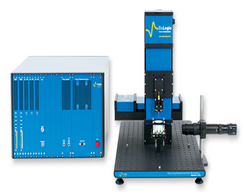
Search

A modular, state-of-the-art instrument allowing users to exploit 9 local electrochemistry techniques.
All scanning probe electrochemistry techniques are characterized by their visualization of local electrochemical characteristics. Unlike bulk electrochemical measurements, which provide an average of the electrochemical nature of a sample, scanning probe electrochemistry allows the correlation of sample features and their electrochemistry. This can provide users with further insight into the causes of the electrochemistry they see in the bulk system. Furthermore, users can understand how different sample features, like step edges, and grain boundaries affect the bulk electrochemistry.
Scanning probe electrochemistry encompasses a range of techniques, which provide complementary information. The M470 can perform Scanning Electrochemical Microscopy (SECM), Intermittent Contact-SECM (ic-SECM), Localized Electrochemical Impedance Spectroscopy (LEIS), Scanning Vibrating Electrode Technique (SVET) (also known as vibrating probe), Scanning Kelvin Probe (SKP), Scanning Droplet Cell (SDC) and Optical Surface Profiling (OSP). Through a selection of the different modules a researcher can investigate:
The combination of these allows a complete description of the sample under study to be obtained.
Scanning probe electrochemistry has found use in any field in which researchers would like to further understand the factors contributing to the bulk electrochemistry measured. It has been firmly established in corrosion research, with the particular aim of understanding where and how corrosion processes start. In corrosion research, scanning electrochemical techniques are also used to determine the effectiveness of a treatment or coating and how improvements can be made to further passivate a system. In biology, scanning probe electrochemistry has been used to investigate living cells and particular emphasis has been placed on its use in screening biosensors. In the energy sector scanning probe electrochemistry has found use investigating batteries, fuel cells and photovoltaics. Materials science also benefits from the use of scanning probe electrochemistry, which has even been used to investigate 2D materials.
The M470 is the fourth generation scanning probe electrochemistry instrument available from Bio-Logic. Building on previous generations the M470 offers the highest level of flexibility yet. Users can select from seven different module types to perform nine different scanning probe techniques. This gives users a range of information from topography to electrochemical activity to sample current. The M470 adapts dynamically to the needs of researchers. Its modular nature means users can add further techniques, as and when experimental needs arise. All module electronics fit within the same control unit allowing users to grow their technique catalog without growing the spatial requirements of the instrument. A full range of probes and accessories is also available for users to fine-tune the M470 to meet their experimental needs.
The M470 scanning stage has been designed for scanning probe electrochemistry measurements. This means high resolution and high accuracy measurements. The movement of the scanning stage is highly repeatable without hysteresis. It maintains rectilinear movement, meaning the stage will not undergo twisting out of the axis of movement. Cross talk between the three axes is avoided. The M470 uses a closed-loop positioning system. The combination of these elements allows the M470 scanning stage to achieve high resolution and high accuracy measurements which do not show artifacts due to the positioning system.
Not every experiment is the same. Keeping this in mind, the M470 software provides a number of tools to allow users to design their experiment. With the Experiment Sequence option, users can automatically run a series of experiments and logic steps. This gives users access to all of the experiments available to their M470, as well as scanning stage movements and delays. Custom experiments can also be written for the M470 using its fully programmable macro language. Finally, the Modular Map SECM experiment allows users of the SECM470 greater flexibility in their experimental configuration.
The SECM470 module includes both dc-SECM and ac-SECM techniques. dc-SECM uses a redox mediator to measure local electrochemical activity of the sample at a constant height. ac-SECM also measures the local activity of the sample at a constant height. Because impedance is now measured a redox mediator is not needed. ac-SECM may also be used to measure individual EIS spectra
ic-SECM470 includes both ic-dc-SECM and ic-ac-SECM. With the ic-SECM470 option, the user can measure the local sample activity and topography with chemical selectivity with a constant distance between the probe and sample. Through a single experiment, the user obtains both a sample activity and a sample topography map.
LEIS470 allows both LEIS and Local Electrochemical Impedance Microscopy (LEIM) measurements. In LEIS point-by-point impedance spectra are measured. When LEIM is used local impedance differences can be mapped in x,y at a single ac frequency.
SVP470 performs the Scanning Vibrating Electrode Technique (SVET)/Vibrating Probe experiments. In SVET the local current distribution of a sample in electrolyte is measured.
SKP470 performs the SKP experiments. Using SKP the Volta potential , which is directly related to the sample work function of a sample can be measured without contact or exposure to the electrolyte. SKP470 also includes two topography techniques for use in constant distance SKP measurements.
Using the SDS470 module ac- and dc-SDC measurements can be performed. Using SDC direct electrochemical and impedance measurements can be performed within a droplet, which can also move across a surface.
The OSP470 module makes use of the diffracted light of a laser beam to perform OSP measurements. As such OSP is a non-contact, high speed, topography measurement. Results from the OSP470 measurements can be used in all M470 height tracking measurements to allow constant distance measurements.